Sideroxylon inerme
| Botanical Name | Sideroxylon inerme |
|||||||||||
| Family | Sapotaceae - The milkwood family. |
|||||||||||
| Pronunciation | sy-der-oh-ZY-lon in-ER-me |
|||||||||||
| Common Name(s) |
English: White milkwood
Afrikaans: Witmelkhout; Jakkalsbessie
IsiXhosa: umqwashu; umnweba
IsiZulu: aMasethole-amhlope; uMakhwela-fingqane; Umaphipha
Tshivenda: Mutaladzi-vhufa
|
|||||||||||
| Plant Group |
|
|||||||||||
| Plant Size |
|
|||||||||||
| Position |
|
|||||||||||
| General Information |
|
|||||||||||
| Specific Information | Sideroxylon inerme has a sturdy trunk and a large, dense, rounded crown. The flowers have a strong, unpleasant smell. The shiny fruits are almost black and are eaten by birds. People with homes situated where fires frequently occur, may consider planting a row of milkwoods, as this tree makes an excellent firebreak. Sideroxylon inerme is a protected tree in South Africa, meaning that no milkwood may be damaged, moved or felled. There is often confusion when trying to tell a Milkwood from a Cheesewood (Pittosporum viridiflorum), as the leaves often look very similar. Break off a tip shoot. If thick, white sap oozes from the stem, it is a milkwood. The cheesewood stem is quite brittle and has no leaking sap. |
|||||||||||
| Ad Break | ||||||||||||
| Flowers | ||||||||||||
| Description | very small - almost insignificant |
|||||||||||
| Season |
|
|||||||||||
| Colour |
|
|||||||||||
| Growth Rate |
|
|||||||||||
| Plant Uses |
|
|||||||||||
| Distribution and Habitat | along the coast from Cape Town in the Western Cape, through the Eastern Cape, KwaZulu-Natal, Mpumalanga and Limpopo, as well as in Zimbabwe and southern Mozambique, in dune and seashore forests, in coastal woodlands and forests |
|||||||||||
| Planting Suggestions | Although growing predominantly along the coast, Sideroxylon inerme cannot tolerate direct salt-laden sea wind, which causes burn damage, so plant it where a windbreak or alcove offers it some protection. This is a sand tolerant tree but the addition of plenty of compost and fertiliser will give it a head start. The old method of digging a deep hole and filling it with soil and compost has resulted in many trees failing to thrive, dying, rotting at the base or worse still, falling over in later years due to poor root development. Refer to the following sites for the best method of planting trees: International Society of Arboriculture: New Tree Planting Tree People: Plant the right way For those of you who have a clay problem try: |
|||||||||||
| Medicinal Uses | The ripe purple-black berries with juicy flesh and sticky white juice are said to be edible. (The juice is really tacky and difficult to remove from the hands.) |
|||||||||||
| Ad Break | ||||||||||||



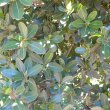
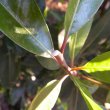
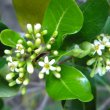
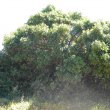
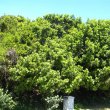
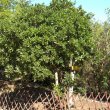


Comments
sideroxylon inerme
Hi
Does anyone know whether the fruit has any nutitional value, eg iron or vitamin C
Hi Delene
Hi Delene
I have found no information in this regard. As mentioned, there is no definite proof that these fruits are edible for human consumption. I certainly wouldn't want to try them - the juice is tacky and sticks to the skin like latex.
Regards
Lorraine
White milkwood fruit
Thanks so much.
Kind regards
Delene
Gardening under Milkwoods
Hi Lorraine. I have a number of established milkwood trees in my coastal garden in Port Alfred, Eastern Cape. Can you suggest some plants and shrubs I could plant under the trees as nothing seems to grow there. It is a holiday home so I would prefer indigenous plants as watering is a problem. Thanks.
What grows under White Milkwoods?
Hi Jenny
As I live in Bathurst, I understand and sympathise with your dilemma. Almost nothing grows under my Milkwoods either. The shade they cast is deep and the Milkwoods seem to suck up all the water and nutrients. Your choices are further limited as the plants will not receive extra water. Here are some ideas:
Succulents: Crassula multicava, Crassula streyi and Crassula spathulata; Aptenia cordifolia; Gasteria excelsa
Bulbs: Veltheimia bracteata - I have seen these growing in the bush almost up to the East beach. I have some Crinum moorei that are growing well under one of my Milkwoods; Sansevieria hyacinthoides; Albuca nelsonii; Strelitzia reginea
Perrenials: Barleria obtusa - only the natural blue one, (the hybrids won't survive); Plectranthus madagascariensis var. madagascariensis; Plectranthus verticallatus; Plectranthus neochilus; Asparagus densiflorus;
Shrubs: Haleria lucida, Pavetta revoluta
Your main problem will be that no matter how adaptable the plants are, they will need need a couple of months of care before they can be left to themselves. If you have water available, you could possibly hire a neighbour or a pensioner to come in and water the plants on a bi- or tri-weekly basis.
I hope this is of some help.
Kind regards
Lorraine
milkwood
Hi, the milkwood's leaves turn pale and and then the tree dies. Any possible reason. Thank you
Milkwood died
Hi Linda
Without more information, it is impossible to make a useful diagnosis. The tree may have died from too little water, too much water, disease, insect activity in roots, trunk or leaves, age, unsuitable climate, heavy frost, disturbance of the roots, chemical leakage, pool water...the list goes on.
All I can say with certainty is that the tree was already dying, which is why the leaves turned pale.
Sorry I can't be of more help.
Kind regards
Lorraine
Jakkalsbessie
Hi Lorraine
The White milkwood's common name in Afrikaans is not Jakkalsbessie but the name Witmelkhout is correct. The Diospyros mespiliformis, the "Jackalberry" also known as "African Ebony" and by its Afrikaans name "Jakkalsbessie",is a large deciduous tree found mostly in the savannas of Africa. The Witmelkhout and the Jakkalsbessie are two very different trees!
Thanks for your web site the information is very help full.
Common names
Hi Andre
Thanks for your helpful comment. I get many of my common names from SANBI's Red List of South African Plants and this is where I found the name: http://redlist.sanbi.org/species.php?species=3380-1
I must admit that I routinely accept SANBI data to be 'the last word' in accuracy. Could SANBI be wrong? Possibly, but vernacular names are not always reliable from a botanical point of view. Quite frequently different species share common names, some of which are very localised.
I do agree with you however that the common name 'Jakkalsbessie' is most strongly linked to Diospyros mespiliformis.
Kind regards
Lorraine
SAP DAMAGE TO VEHICLES PARKED IN THE SHADE OF MILKWOODS IN HOUT
how does one remove the sap spots from vehicle paintwork? IS THIS A LATEX?
Sap damage to vehicles
Hi Margaret
The sap of the White milkwood is indeed a latex. As to how you would remove it from the paintwork on cars, I wouldn't like to even hazard a guess. In your position I would make contact with a reliable motor spray- painting concern and ask them for advice.
When you do find out how to remove it, please share your findings with us. I am sure there must be other readers with a similar problem.
Kind regards
Lorraine
Relevant and rich site for information
I am really enjoying all the information of your site Lorraine. Thansk very much.
Sideroxylon inerme
The three volume Trees of Southern Africa lists "Jakkalsbessie" as a colloquial name for this species, yet another example of problems with colloquial names. I think "Ysterhout" holds the record for confusion still however.
Colloquial names
Hi Walter
Thanks for your affirmation. When I get a query like the above, I start to doubt my information and go scampering through my sources to make sure I have not made an error. "Ysterhout" is definitely over-used, "Mahogany" but my nightmares begin with many of the smaller plants and shrubs. Amongst others, colloquial names such as Ambeiebos, Bitterbossie, Gousblom, Karoo bossie, Slangkop and Aandblom are ascribed to 4 or 5 different species each. Very confusing!
Kind regards
Lorraine
How to transplant a Mature Specimen.
I would like to know if it is possible to transplant a mature specimen (trunk calibre approximately 300mm and canopy height approx 2 - 2.5metres), as well as the sucess rate and the proceedure.
Relocating a mature tree
Hi Johnnie
It is possible to transplant this tree but as I have no experience in transplanting this species so I cannot comment on success rate.
Transplanting a mature tree has many pitfalls to avoid and procedures to follow to ensure, as far as possible, that the transplant is a success. I have found the information and instructions on the following three sites very helpful in the past:
http://www.savatree.com/mature-tree-transplants.html
http://www.washingtonpost.com/lifestyle/home/how-to-move-a-prized-tree/2...
http://www.colostate.edu/Depts/CoopExt/4DMG/Trees/movetree.htm
Hope this helps.
Kind regards
Lorraine
Smelly Milkwood
Hi Lorraine
We have a Milkwood planted right next to our living room. It gives off an awful stench. We would ultimately need to move it. Is there anyway we can stop it from producing berries?
Thanks Teresa
Milkwood and unpleasant odour
Hi Theresa
This tree is really in an unfortunate position.
I suppose you could spray the entire tree with insect poison on a regular basis during flowering time to prevent pollination. This would also kill off a multitude of bees and other insects, as well as having a negative and possibly devastating effect on certain bird, lizard, gecko and other small wildlife populations that rely on the tree as a food source or living environment. It could also have harmful effects on the occupants of the home. In other words, not a solution but a severe blow to the natural balance of your environment.
The best solution is to remove the tree.
Kind regards
Lorraine
MILKWOOD BLOWN OVER
I recently moved into a new home with a very overgrown garden. It was necessary to have some of it cleared and in so doing, uncovered a young MILKWOOD tree. It had been growing towards the light and as a result has a very long spindly trunk. Sadly during heavy winds, it broke at its base and fell over but is still attached in a small area. I'm sure the stump will grow again but it seems so sad to waste the tree as it is still alive. Would it be possible to replant it?
Growing White Milkwood from a truncheon
Hi Yvonne
As much as I would like to give you hope, I very much doubt that you will be able to save the broken part of the stem. However, it is worth a try. I am not too experienced at growing truncheons, but I found and copied the following very clear instructions from page 22 of this download: www.nobrainer.co.za/file.php?fileId=3369
1. The best time to cut truncheons is in June, July or August when trees are
growing slowly because it is cold. Cut truncheons from trees that drop a
white sap when cut. Only cut truncheons once the trees have formed
new buds. You will not have much success if you plant truncheons later
than November.
2. Cut thick branches with a saw or an axe. The branches can be as tall as
an adult person. Cut the top of the truncheon at a slant, so that water
runs off and does not cause the truncheon to rot. The slant also shows
you which way up to plant the truncheon.
3. Leave the truncheons to lie in the shade for a few days so that a hard
layer forms over the cut ends. If you put the truncheons into the soil
soon after cutting them, then they may rot.
4. Dig a narrow hole. Place half to two-thirds of the truncheon into the soil.
Pack the soil firmly around each truncheon.
5. If there is no rain, water the truncheons until they are growing strongly.
You can use a rooting hormone which you can get at hardware shops, nurseries and garden centres, on the end of the truncheon.
Best of luck.
Kind regards
Lorraine
Thanks so much, Lorraine, for
Thanks so much, Lorraine, for this info! I'm going to give it a try " nothing ventured, nothing gained" as they say. I hate to see a tree die.
Kind regards,
Yvonne
MILKWOOD TREE BERRIES
I have 4 milkwood trees in my garden. Why does one of them carry large amounts of berries and the others do not? Male / female? The tree under stress, lack of water?
Variable quantities of berries
Hi Neil
This is normal for many tree species. Some of my White milkwoods have never produced berries, others produce varying amounts of berries. Some trees produce copious amounts of berries one season then don't produce berries at all the next season. This could be caused by the slightest difference in pH, position, soil fertility, water supply, drainage, mineral variation or insect activity.
Kind regards
Lorraine
Milkwood flies
Hi Lorraine!
Sorry for my English...I'm Italian and, at the moment, I'm having a very, very big problem with milkwood flies! In the back of my garden I have ten milkwood trees and for more than two weeks I cannot open the windows because there are hundreds and hundreds of flies! The walls, the windows and the roof of the patio are black with flies...it's like a nightmare! I tried with a pesticide but it's not enough...the day after there are more and more!
Please, can you tell me what can I do....I'm very desperate! How long they usually stay?
Waiting for your answer I thank you in advance!
Maria
Fly invasion
Hi Maria
You really do have a problem! The flowers of these trees smell really bad so as to attract flies to pollinate them. The flies can smell the odour from long distances away are are drawn to the flowers under the impression that something is rotten where they can feed and lay their eggs. As soon as the flowering season is over, the flies will disappear. I am not sure but I think this will take about three weeks - longer if the trees flower at slightly different times.
The only suggestion I can make is to buy fly traps from the hardware store and hang them between the trees and the house. Unfortunately these traps also smell pretty bad, which will mean you cannot use the yard and will probably still have to keep the windows closed.
Removing the trees would be the only way to solve your problem permanently but there lies another obstacle. White milkwoods are protected trees in South Africa and it is illegal to remove these trees without a permit from the Nature Conservation authorities - even if they are growing on your own property.
I am sorry that I cannot make any really useful suggestions. Perhaps another reader will be able to give us other ideas.
Kind regards
Lorraine
Fly invasion
Many thanks, Lorraine, for your kind answer!
Things are going better now...I was so in despair that I tried anything! Every morning and often twice a day I washed all the back of the house with the water pipe to remove most of the flies. I also washed the windows and the walls with white vinegar and put bowls with vinegar on the patio....I can say it's better now!!!
Kind regards
Maria
Flies on White milkwoods
Hi Maria
You must be relieved the flowering season is over. You will probably have this problem every year at flowering time, but at least you can be prepared for it. Hopefully it will not always be so bad.
Kind regards
Lorraine
Dying new leaves on White Milkwood
Is this characteristic of Milkwoods? They lose a lot of leaves on the ends and look a bit sick. People keep wondering if it's a chronic disease - or a normal yearly shedding. Thanks Lyn
White Milkwood leaves dying
Hi Lyn
Most evergreen trees do shed a larger quantity of leaves than normal at a certain time of the year. The leaves go yellow and fall to the ground. A flush of new growth usually follows. If the leaves keep dying over a period of longer than about a month and branches look bare or start dying off, this would indicate a problem of some sort. Has this happened before? If you are concerned that there is a bigger problem, please send me photos of the whole tree, a close-up of a branch with dying leaves and a close up of the leaves themselves.
Kind regards
Lorraine
White Milkwood leave disease/parasites
I have a number of milkwoods on my property, some 100m from the tidal mark. At times the leaves of the milkwoods seem to be getting small white, fluffy colonies (the size of a match head) of growth/bugs underneath the leaves. The leaves then get an indentation (bulge) in the leave where the colony of pests are. With time the white fluffy colonies on the bottom of the leaves turns brown. The leaves remains disfigured. This "infection" comes and goes. It can spread rapidly throughout the trees and tends to affect the sunny side and wind protected sides of the trees more.
This parastic white fluffy growth dont seem to affect tne trees that much, exept for permanently disfiguring the leaves. There are plenty of birds in the garden, and smaller species of wild doves loves to make nests in the dense foilage.
I'm tryingto control these white fluffy colony outbreaks by removing affected leaves/shoots.
What can one o about this white fluffy parasitic type colony growth?
Regards
Psylla
Hi Johann
Sincere apologies for not having replied to your query for such a long time.
The bumps on the leaves are caused by an insect called Psylla. The adult looks much like an aphid with wings. The immature insects feed on the underside of the leaves which causes the galls. If heavily infested the leaves may turn yellow and drop off. There are many species of Psylla that attack different varieties of plants.
Although I don't encourage the use of poisons, the following can be used: Chlorpyrifos, Aphicid, Aphidsprey or Metasystox.
For biological control Insecticidal soap and certain oil based mixtures are suggested but I do not know brand names for these - you would have to contact a knowledgeable nursery-person, or perhaps Margaret Roberts will be best able to help with organic control - www.margaretroberts.co.za/
I have had this problem on White Milkwoods as well as the Cape Ash. I have noticed that the insects infest only certain trees each season. My best Cape Ash specimen was attacked two years ago but there has been no sign of galls since then. I just ignore them as control is very difficult when you have a large number of trees.
Kind regards
Lorraine
Root system of white milkwood tree
What kind of root system does the melkhout tree have. I intended to plant one at my holiday home in Stilbaai. After reading about the smell around flowering time I have some doubts. But there are lovely specimens in Stilbaai in some gardens.
Kind regards
William
"Oumansbaard" (parasite plants) on Milkwood Trees
In Stilbaai this is a serious problem . And this unknown parasite plant which looks like Oumansbaards definitely kills the milkwood trees and all other vegetation . When walking through the forest of milkwoods the presence of this parasite gives the idea of eeriness like a scene in The Lord of the Rings . What is the name of this parasite plant and what can we do to prevent it from killing this wonderful tree ?
milkwood
As a matter of interest why are milkwood trees protected? Reading the queries here, regarding the smell etc, to me it sounds more like a "
problem" tree. I was thinking of planting one but now not so sure
Why are Milkwoods protected trees?
Hi Merryl
My apologies for not replying to your query sooner.
Trees selected for protection status are not chosen for their usefulness in a garden or city environment. These trees are chosen for a number of far-reaching reasons with regard to the natural environment of the country as a whole. Some of the criteria used are as follows:
Red list status: is the tree rare or becoming rare in its natural habitat;
Whether species plays a dominant role in an ecosystem’s functioning;
Sustainability of Use - whether a species is threatened by heavy use of its products such as timber, bark etc;
Cultural or Spiritual Importance - does the tree have outstanding landscape value or spiritual meaning attached to it.
So why the Milkwood?
The smelly flowers provide a food source large population of various types of flies and other bugs as well as speckled mousebirds.
The fruits provide food for birds, bats, monkeys and bush pigs.
The bark and roots have a number of medicinal uses.
The majority of milkwoods grow all along the beaches of the east coast of South Africa on poor dune soil, stabilising the dunes, preventing erosion and enriching the soils.
Added to all of this is the fact that the Milkwood makes an excellent, natural fire break and they have been known to stop a fire dead in its tracks. This is of special use in the dune area where a rampant fire would cause a disastrous situation that would take years and years to recover.
Milkwoods can grow to be many hundreds of years old. Many of these very old trees were cut down in earlier times as the wood is very hard and was used for building bridges, boats and mills.
All told, the Milkwood plays a vital role as a member and protector of Dune and coastal forest biomes.
And that is why it is a protected tree.
Kind regards
Lorraine
Discuss this plant
Share knowledge, ask a question or give an experience.